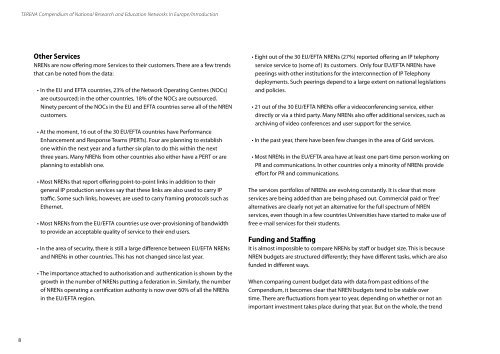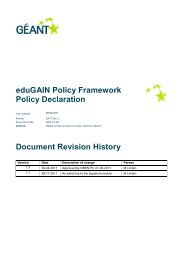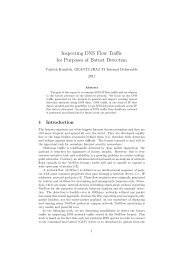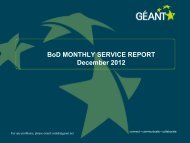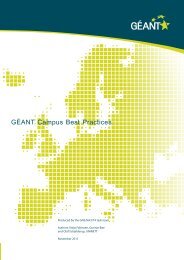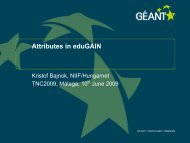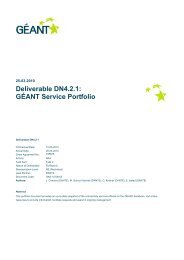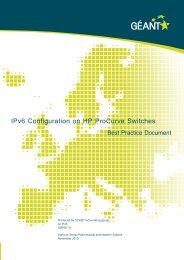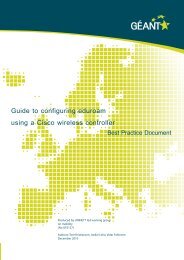TERENA COMPENDIUM - Géant
TERENA COMPENDIUM - Géant
TERENA COMPENDIUM - Géant
Create successful ePaper yourself
Turn your PDF publications into a flip-book with our unique Google optimized e-Paper software.
<strong>TERENA</strong> Compendium of National Research and Education Networks In Europe /IntroductionOther ServicesNRENs are now offering more Services to their customers. There are a few trendsthat can be noted from the data:• In the EU and EFTA countries, 23% of the Network Operating Centres (NOCs)are outsourced; in the other countries, 18% of the NOCs are outsourced.Ninety percent of the NOCs in the EU and EFTA countries serve all of the NRENcustomers.• At the moment, 16 out of the 30 EU/EFTA countries have PerformanceEnhancement and Response Teams (PERTs). Four are planning to establishone within the next year and a further six plan to do this within the nextthree years. Many NRENs from other countries also either have a PERT or areplanning to establish one.• Most NRENs that report offering point-to-point links in addition to theirgeneral IP production services say that these links are also used to carry IPtraffic. Some such links, however, are used to carry framing protocols such asEthernet.• Most NRENs from the EU/EFTA countries use over-provisioning of bandwidthto provide an acceptable quality of service to their end users.• In the area of security, there is still a large difference between EU/EFTA NRENsand NRENs in other countries. This has not changed since last year.• The importance attached to authorisation and authentication is shown by thegrowth in the number of NRENs putting a federation in. Similarly, the numberof NRENs operating a certification authority is now over 60% of all the NRENsin the EU/EFTA region.• Eight out of the 30 EU/EFTA NRENs (27%) reported offering an IP telephonyservice service to (some of) its customers. Only four EU/EFTA NRENs havepeerings with other institutions for the interconnection of IP Telephonydeployments. Such peerings depend to a large extent on national legislationsand policies.• 21 out of the 30 EU/EFTA NRENs offer a videoconferencing service, eitherdirectly or via a third party. Many NRENs also offer additional services, such asarchiving of video conferences and user support for the service.• In the past year, there have been few changes in the area of Grid services.• Most NRENs in the EU/EFTA area have at least one part-time person working onPR and communications. In other countries only a minority of NRENs provideeffort for PR and communications.The services portfolios of NRENs are evolving constantly. It is clear that moreservices are being added than are being phased out. Commercial paid or ‘free’alternatives are clearly not yet an alternative for the full spectrum of NRENservices, even though in a few countries Universities have started to make use offree e-mail services for their students.Funding and StaffingIt is almost impossible to compare NRENs by staff or budget size. This is becauseNREN budgets are structured differently; they have different tasks, which are alsofunded in different ways.When comparing current budget data with data from past editions of theCompendium, it becomes clear that NREN budgets tend to be stable overtime. There are fluctuations from year to year, depending on whether or not animportant investment takes place during that year. But on the whole, the trend8


